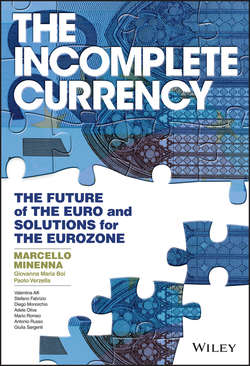Читать книгу The Incomplete Currency - Marcello Minenna - Страница 16
На сайте Литреса книга снята с продажи.
Chapter 1
The Building Blocks of the Single European Currency
1.1 The Basic Concepts: Financial Flows, Risks and Probability Distribution
1.1.3 The Credit Risk
ОглавлениеFrom the arguments made in the previous section it is clear that every bank can calculate its own swap rate according to variable interest rates that it pays, and these swap rates can be different according to the issuer.
How do we explain these differences?
As usual, we start with a very simple example. We have a very solid issuer, which basically cannot fail (e.g. in this historical period, the market considers that of Germany). In this case, applying the methodology previously described, it is fairly straightforward to calculate the swap rate for this issuer (1.1 % per annum). Since the swap rate is a fixed rate, we can construct the probability distribution of the bond of our solid issuer (Bond D) which pays the swap rate of 1.1 % per annum. Let's have a look.
The probability distribution calculated in the first panel of Figure 1.6 is rotated and shown in an enlarged form in the second panel. On the horizontal axis of the blue figure, the possible values of the bond at maturity are plotted, while on the vertical axis it is shown how often these possible values are going to be achieved. From the analysis of the distribution it is clear that investors at maturity will clearly get back the capital invested (€100), inclusive of the accrued coupons that are based on the swap rate of 1.1 % per annum (represented by the spread of the distribution around the value of €102).
Figure 1.6 Probability distribution of the values at maturity of a 2-year floating-rate bond issued by State D
Now let's imagine a state that's not so “solid”, where there are serious doubts that it can fulfil the obligation to repay the capital at the maturity and/or pay the eventual periodic coupons (for example, Greece today). The government of this state (GR) issues a bond that pays the same rate as solid State D, which is still 1.1 % per annum.
Intuitively, the bond issued by GR looks riskier, but pays the same rate as that of State D. How will the probability distribution of this bond look and what would be the fair price that the investor would have to pay? Figure 1.7 answers our questions.
Figure 1.7 Probability distribution of the values at maturity of a 2-year floating-rate bond issued by State GR
Figure 1.7 shows that in a number of cases it is possible that State GR doesn't pay back the capital at maturity and doesn't pay some coupons, going into default. Since in these cases the investor will get much less than the promised return, it is fair that today the bond is cheaper, since he bears the risk of possible losses.
Conclusion: a riskier bond as a result of the possibility of default of the issuer, with the same return offered, is worth less than a risk-free bond.
Now it is clear that a bond from GR that only pays 1.1 % per annum is not very attractive to investors. There is only one possibility for the State GR in order to raise funds on the markets: to make bonds more appealing for the investor by increasing the interest rate offered.
It's clear that if profit rises, the fair price that an investor would have to pay to buy the bond would rise too. If the profit increases sufficiently to bring the fair price to the value of the risk-free bond of State D (100), the investor will be completely compensated for the credit risk of the State GR by higher yields.
Conclusion: a riskier bond as a result of the possibility of the issuer's default pays more than a risk-free bond with the same fair price.
At this point of the analysis a question arises: how can market participants measure the credit risk of a specific issuer?
The default risk of a sovereign issuer can be observed and measured through complex statistics on the health of the economy and public finances; clearly these data provide estimates subject to a certain variability and implemented in a given moment, while operators need constantly updated and trustworthy information in order to close their financial transactions in real time. Other indicators are therefore needed for their businesses.
The solution is simpler than one can imagine: we said that a riskier bond, to be successfully sold, must pay more. Consequently, the differential (the so-called credit spread) of yield between a risky bond issued by State GR and a risk-free bond like that issued by State D is an immediate and safe measure of the credit risk perceived by the operators. This reasoning is summarised in Figure 1.8.
Figure 1.8 Probability distribution of the values at maturity of a 2-year fixed rate bond issued by State D and of a 2-year fixed rate bond issued by State GR
The more that an issuer is considered risky, the more it will have to pay in order to sell his bonds at an issue price equal to that of the risk-free bond of State D (see Figure 1.9).
Figure 1.9 Probability distribution of the values at maturity of a 2-year fixed-rate bond issued by State D, of a 2-year fixed rate bond issued by State GR, and of a further 2-year fixed rate bond whose issuer is riskier than GR
